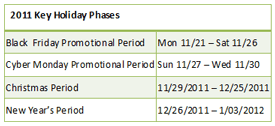My desk is a mess. My inbox has dozens (ok, hundreds) of unread emails. What I am trying to say is that I’m not going to win any awards for my organizational skills. However, when it comes to building a holiday marketing plan, I have a savant-like obsession with making sure everything is in place.
 |
Why? Because I have experienced the 12+ hour days and midnight team meetings to “figure out what we need to do” and honestly, I would rather spend the holidays in a less stressful and unpredictable environment.
Starting your plan early is great, however timing is not everything. Understanding which tasks benefit most from early planning will help ensure you move into the holiday season with your plan ready and a fully checked off to-do list.
Even though July is months before the full roar of the holiday season, this is the time to kick off your planning for some of the potentially most time consuming tasks.
After the barbeques and fireworks have ended, here’s what needs to be on your calendar (see chart).

This is also the time to start drafting your communication plan. Knowing which promotions resonated the most with your subscribers, as well as the timing and frequency of messages from the past season, will help you anchor optimal messaging times for this year.
Partner collaboration
You will probably start receiving emails in August from your partners letting you know when their code freeze will begin. The code freeze date may not be until late October, but when you factor in the planning, development, testing and implementation for new integrations, modifications to existing data exchanges or other backend processes, it becomes clear that conversations about this with your vendors and partners should start now. Review your full list of partners and audit the programs you currently have in place. Determine if any changes made during the year, such as modifications to your checkout process or alterations to the data collected in opt-in forms, impact how systems interact. Having these updates in place in advance will ensure systems run smoothly, segmentation options are maximized, and customers have a positive shopping experience.
Set expectations with your ESP
Holiday email volume continues to increase each year. Last year, 29% of brands sent two or more emails on Cyber Monday, the peak day of the season for email volume. Discuss your mailing frequency with your Email Service Provider to determine if there are tactics such as streamlining segmentation, using dynamic content, or automating certain messages that could save valuable time and make email production and execution more efficient.
If you belong to the 87% of brands not sending abandoned cart messages, now is the time to ask your ESP how to best implement these automated, revenue-generating emails. With abandonment rates hovering around 70% and conversion rates of 20% from abandoned cart emails, you are missing out on some serious dollars. Developing the message stream and implementing the supporting technology for your abandoned cart program may take some time and effort so starting these conversations now allows time for testing and modifications before the holiday season reaches full steam.
As July passes, planning should begin to focus more on solidifying a communication plan and developing specific campaigns. Remember, the more you plan now, the more you can focus on enjoying the holiday season.
Jim Davidson is manager of marketing research for Bronto Software.
